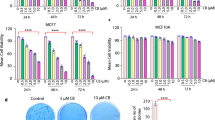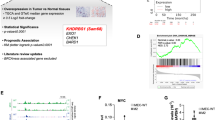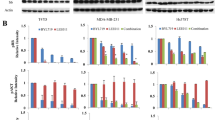Abstract
Commonly used drugs for the treatment of breast cancer patients like paclitaxel and Herceptin often show severe side effects or induce resistance in clinical settings. Thus, we analysed a combination of Plk1 (polo-like kinase 1)-specific small interfering RNAs (siRNAs), a powerful tool to induce ‘mitotic catastrophe’ in cancer cells, together with these drugs to identify conditions for enhanced drug sensitivity. After transfection, the antineoplastic agents were added and cell proliferation, apoptosis and cell cycle distribution in breast cancer cells (MCF-7, SK-BR-3, MDA-MB-435 and BT-474) and in primary human mammary epithelial cells were determined. Downregulation of cellular Plk1 levels led to an elevated percentage of cells in G2/M phase. The percentage of apoptotic nuclei in MCF-7, MDA-MB-435, SK-BR-3 and BT-474 cells was clearly increased after incubation with Plk1-specific siRNAs and paclitaxel. Interestingly, the caspase pathway was activated after treatment with Plk1-specific siRNAs and paclitaxel or Herceptin. Treatment of breast cancer cells with siRNAs targeting Plk1 improved the sensitivity toward paclitaxel and Herceptin in a synergistic manner. In all experiments, very low concentrations across a wide range of clinically relevant concentrations were sufficient to induce an antiproliferative effect. The combination of Plk1-specific siRNAs with modern breast cancer drugs seems to represent rational combinations to be tested in preclinical trials.
This is a preview of subscription content, access via your institution
Access options
Subscribe to this journal
Receive 50 print issues and online access
$259.00 per year
only $5.18 per issue
Buy this article
- Purchase on Springer Link
- Instant access to full article PDF
Prices may be subject to local taxes which are calculated during checkout








Similar content being viewed by others
References
Ahmad N . (2004). Polo-like kinase (Plk) 1: a novel target for the treatment of prostate cancer. FASEB J 18: 5–7.
Ando K, Ozaki T, Yamamoto H, Furuya K, Hosoda M, Hayashi S et al. (2004). Polo-like kinase 1 (Plk1) inhibits p53 function by physical interaction and phosphorylation. J Biol Chem 279: 25549–25561.
Barr FA, Sillje HH, Nigg EA . (2004). Polo-like kinases and the orchestration of cell division. Nat Rev Mol Cell Biol 5: 429–440.
Blain SW, Scher HI, Cordon-Cardo C, Koff A . (2003). p27 as a target for cancer therapeutics. Cancer Cell 3: 111–115.
Blajeski AL, Kottke TJ, Kaufmann SH . (2001). A multistep model for paclitaxel-induced apoptosis in human breast cancer cell lines. Exp Cell Res 270: 277–288.
Check E . (2005). A crucial test. Nat Med 11: 243–244.
Chen X, Yeung TK, Wang Z . (2000). Enhanced drug resistance in cells coexpressing ErbB2 with EGF receptor or ErbB3. Biochem Biophys Res Commun 277: 757–763.
Chou TC, Talalay P . (1984). Quantitative analysis of dose–effect relationships: the combined effects of multiple drugs or enzyme inhibitors. Adv Enzyme Regul 22: 27–55.
Clynes RA, Towers TL, Presta LG, Ravetch JV . (2000). Inhibitory Fc receptors modulate in vivo cytoxicity against tumor targets. Nat Med 6: 443–446.
Cogswell JP, Brown CE, Bisi JE, Neill SD . (2000). Dominant-negative polo-like kinase 1 induces mitotic catastrophe independent of cdc25C function. Cell Growth Differ 11: 615–623.
Crown J, Pegram M . (2003). Platinum–taxane combinations in metastatic breast cancer: an evolving role in the era of molecularly targeted therapy. Breast Cancer Res Treat 79 (Suppl 1): S11–S18.
Dai D, Holmes AM, Nguyen T, Davies S, Theele DP, Verschraegen C et al. (2005). A potential synergistic anticancer effect of paclitaxel and amifostine on endometrial cancer. Cancer Res 65: 9517–9524.
Dubska L, Andera L, Sheard MA . (2005). HER2 signaling downregulation by trastuzumab and suppression of the PI3K/Akt pathway: an unexpected effect on TRAIL-induced apoptosis. FEBS Lett 579: 4149–4158.
Eckerdt F, Yuan J, Strebhardt K . (2005). Polo-like kinases and oncogenesis. Oncogene 24: 267–276.
Elbashir SM, Harborth J, Lendeckel W, Yalcin A, Weber K, Tuschl T . (2001). Duplexes of 21-nucleotide RNAs mediate RNA interference in cultured mammalian cells. Nature 411: 494–498.
Esteva FJ, Valero V, Booser D, Guerra LT, Murray JL, Pusztai L et al. (2002). Phase II study of weekly docetaxel and trastuzumab for patients with HER-2-overexpressing metastatic breast cancer. J Clin Oncol 20: 1800–1808.
Gleave ME, Monia BP . (2005). Antisense therapy for cancer. Nat Rev Cancer 5: 468–479.
Gumireddy K, Reddy MV, Cosenza SC, Boominathan R, Baker SJ, Papathi N et al. (2005). ON01910, a non-ATP-competitive small molecule inhibitor of Plk1, is a potent anticancer agent. Cancer Cell 7: 275–286.
Jordan MA, Wilson L . (2004). Microtubules as a target for anticancer drugs. Nat Rev Cancer 4: 253–265.
Kauselmann G, Weiler M, Wulff P, Jessberger S, Konietzko U, Scafidi J et al. (1999). The polo-like protein kinases Fnk and Snk associate with a Ca(2+)- and integrin-binding protein and are regulated dynamically with synaptic plasticity. EMBO J 18: 5528–5539.
Lane HA, Beuvink I, Motoyama AB, Daly JM, Neve RM, Hynes NE . (2000). ErbB2 potentiates breast tumor proliferation through modulation of p27(Kip1)-Cdk2 complex formation: receptor overexpression does not determine growth dependency. Mol Cell Biol 20: 3210–3223.
Lane HA, Nigg EA . (1996). Antibody microinjection reveals an essential role for human polo-like kinase 1 (Plk1) in the functional maturation of mitotic centrosomes. J Cell Biol 135: 1701–1713.
Liu X, Erikson RL . (2003). Polo-like kinase (Plk)1 depletion induces apoptosis in cancer cells. Proc Natl Acad Sci USA 100: 5789–5794.
Liu X, Lei M, Erikson RL . (2006). Normal cells, but not cancer cells, survive severe Plk1 depletion. Mol Cell Biol 26: 2093–2108.
Marches R, Uhr JW . (2004). Enhancement of the p27Kip1-mediated antiproliferative effect of trastuzumab (Herceptin) on HER2-overexpressing tumor cells. Int J Cancer 112: 492–501.
Mimura K, Kono K, Hanawa M, Kanzaki M, Nakao A, Ooi A et al. (2005). Trastuzumab-mediated antibody-dependent cellular cytotoxicity against esophageal squamous cell carcinoma. Clin Cancer Res 11: 4898–4904.
Nahta R, Esteva FJ . (2006a). HER2 therapy: molecular mechanisms of trastuzumab resistance. Breast Cancer Res 8: 215.
Nahta R, Esteva FJ . (2006b). Herceptin: mechanisms of action and resistance. Cancer Lett 232: 123–138.
Nahta R, Takahashi T, Ueno NT, Hung MC, Esteva FJ . (2004). P27(kip1) down-regulation is associated with trastuzumab resistance in breast cancer cells. Cancer Res 64: 3981–3986.
Nishii K, Kabarowski JH, Gibbons DL, Griffiths SD, Titley I, Wiedemann LM et al. (1996). ts BCR-ABL kinase activation confers increased resistance to genotoxic damage via cell cycle block. Oncogene 13: 2225–2234.
Nogawa M, Yuasa T, Kimura S, Tanaka M, Kuroda J, Sato K et al. (2005). Intravesical administration of small interfering RNA targeting PLK-1 successfully prevents the growth of bladder cancer. J Clin Invest 115: 978–985.
Schiff PB, Horwitz SB . (1980). Taxol stabilizes microtubules in mouse fibroblast cells. Proc Natl Acad Sci USA 77: 1561–1565.
Slamon DJ, Leyland-Jones B, Shak S, Fuchs H, Paton V, Bajamonde A et al. (2001). Use of chemotherapy plus a monoclonal antibody against HER2 for metastatic breast cancer that overexpresses HER2. N Engl J Med 344: 783–792.
Smith MR, Wilson ML, Hamanaka R, Chase D, Kung H, Longo DL et al. (1997). Malignant transformation of mammalian cells initiated by constitutive expression of the polo-like kinase. Biochem Biophys Res Commun 234: 397–405.
Smits VA, Klompmaker R, Arnaud L, Rijksen G, Nigg EA, Medema RH . (2000). Polo-like kinase-1 is a target of the DNA damage checkpoint. Nat Cell Biol 2: 672–676.
Soutschek J, Akinc A, Bramlage B, Charisse K, Constien R, Donoghue M et al. (2004). Therapeutic silencing of an endogenous gene by systemic administration of modified siRNAs. Nature 432: 173–178.
Spankuch B, Heim S, Kurunci-Csacsko E, Lindenau C, Yuan J, Kaufmann M et al. (2006). Down-regulation of polo-like kinase 1 elevates drug sensitivity of breast cancer cells in vitro and in vivo. Cancer Res 66: 5836–5846.
Spankuch B, Matthess Y, Knecht R, Zimmer B, Kaufmann M, Strebhardt K . (2004). Cancer inhibition in nude mice after systemic application of U6 promoter-driven short hairpin RNAs against PLK1. J Natl Cancer Inst 96: 862–872.
Spankuch B, Strebhardt K . (2005). RNA interference-based gene silencing in mice: the development of a novel therapeutical strategy. Curr Pharm Des 11: 3405–3419.
Spankuch-Schmitt B, Bereiter-Hahn J, Kaufmann M, Strebhardt K . (2002a). Effect of RNA silencing of polo-like kinase-1 (PLK1) on apoptosis and spindle formation in human cancer cells. J Natl Cancer Inst 94: 1863–1877.
Spankuch-Schmitt B, Wolf G, Solbach C, Loibl S, Knecht R, Stegmuller M et al. (2002b). Downregulation of human polo-like kinase activity by antisense oligonucleotides induces growth inhibition in cancer cells. Oncogene 21: 3162–3171.
Strebhardt K . (2001). PLK (polo-like kinase). In: Creighton TE (ed). Encyclopedia of Molecular Medicine. Wiley and Sons Inc.: New York, NY, pp 2530–2532.
Strebhardt K, Ullrich A . (2006). Targeting polo-like kinase 1 for cancer therapy. Nat Rev Cancer 6: 321–330.
Templeton NS . (2002). Cationic liposome-mediated gene delivery in vivo. Biosci Rep 22: 283–295.
Therasse P . (2002). Measuring the clinical response. What does it mean? Eur J Cancer 38: 1817–1823.
Vogel CL, Cobleigh MA, Tripathy D, Gutheil JC, Harris LN, Fehrenbacher L et al. (2002). Efficacy and safety of trastuzumab as a single agent in first-line treatment of HER2-overexpressing metastatic breast cancer. J Clin Oncol 20: 719–726.
Xia W, Bisi J, Strum J, Liu L, Carrick K, Graham KM et al. (2006). Regulation of survivin by ErbB2 signaling: therapeutic implications for ErbB2-overexpressing breast cancers. Cancer Res 66: 1640–1647.
Yuan J, Horlin A, Hock B, Stutte HJ, Rubsamen-Waigmann H, Strebhardt K . (1997). Polo-like kinase, a novel marker for cellular proliferation. Am J Pathol 150: 1165–1172.
Yuan J, Kramer A, Matthess Y, Yan R, Spankuch B, Gatje R et al. (2006). Stable gene silencing of cyclin B1 in tumor cells increases susceptibility to taxol and leads to growth arrest in vivo. Oncogene 25: 1753–1762.
Zimmermann TS, Lee AC, Akinc A, Bramlage B, Bumcrot D, Fedoruk MN et al. (2006). RNAi-mediated gene silencing in non-human primates. Nature 441: 111–114.
Acknowledgements
We thank R Knecht and H Baumann for microscopical support. This work is supported by the Nationales Genomforschungsnetz (01GR0431), the Deutsche Krebshilfe (10–1212-St 1), the Wilhelm-Sander-Stiftung (2001.007.2), the Messer-Stiftung, the Schleussner-Stiftung and the Deutsche Forschungsgemeinschaft (SP 1092/1-1).
Author information
Authors and Affiliations
Corresponding author
Rights and permissions
About this article
Cite this article
Spänkuch, B., Kurunci-Csacsko, E., Kaufmann, M. et al. Rational combinations of siRNAs targeting Plk1 with breast cancer drugs. Oncogene 26, 5793–5807 (2007). https://doi.org/10.1038/sj.onc.1210355
Received:
Revised:
Accepted:
Published:
Issue Date:
DOI: https://doi.org/10.1038/sj.onc.1210355
Keywords
This article is cited by
-
Targeting PLK1 overcomes T-DM1 resistance via CDK1-dependent phosphorylation and inactivation of Bcl-2/xL in HER2-positive breast cancer
Oncogene (2018)
-
Continued use of MDA-MB-435, a melanoma cell line, as a model for human breast cancer, even in year, 2014
npj Breast Cancer (2015)
-
Downregulation of ABCE1 via siRNA affects the sensitivity of A549 cells against chemotherapeutic agents
Medical Oncology (2015)
-
Mitosis as an anti-cancer drug target
Chromosoma (2013)
-
Small interfering RNA library screen identified polo-like kinase-1 (PLK1) as a potential therapeutic target for breast cancer that uniquely eliminates tumor-initiating cells
Breast Cancer Research (2012)



